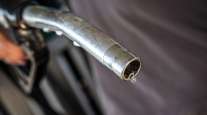Diesel Declines 2.4¢ to $2.748, But Is 32.6¢ Above Year Ago
This story appears in the Dec. 21 & 28 print edition of Transport Topics.
U.S. retail diesel prices dipped for the sixth straight week as the national average declined 2.4 cents to $2.748 a gallon, the Department of Energy reported.
Diesel has declined 6 cents over those six weeks, following a 22.6-cent gain in the previous four weeks. However, the fuel average is now 32.6 cents higher than it was in the corresponding week a year ago, DOE said after its Dec. 14 survey of fueling stations.
DOE also said the retail gasoline average dropped 3.5 cents to $2.599. Although gasoline is now 94 cents a gallon higher than in the corresponding week in 2008, it is below this year’s high of $2.694 a gallon that was reached on Nov. 2.
The fuel price decreases have closely followed a drop in crude oil prices, which slipped below $70 a barrel earlier this month, but crude was on the rise last week, closing at $72.68 a barrel on the New York Mercantile Exchange on Dec. 17.
Analysts attributed the spike in the cost of crude last week to an announcement by OPEC that it expected demand for petroleum to rise in early 2010.
“There’s been a little bit of a bump up in the last few days in the price of crude, so we might see in a week or two a little blip up in diesel prices,” Neil Gamson, an economist at DOE’s Energy Information Administration, told Transport Topics last week.
Gary Brinkley, safety director for Bynum Transport, Auburndale, Fla., said his company is keeping a lid on fuel costs by purchasing diesel in bulk, buying up to 30,000 gallons a day nationwide at about 12 cents a gallon below the national average.
But Brinkley said he’s facing an even tougher challenge with the fuel efficiency of his newer equipment. The company has 200 tankers that haul mostly fruit, dairy and other perishables in 48 states.
He said the company is driving SmartWay-approved trucks and closely monitoring idling, but he’s still burning more fuel than in the past.
The company’s 1990s-vintage trucks are getting up to 7 miles a gallon, but Brinkley said he’s concerned with his 2009 models, which he said are getting no more than 5 mpg.
Although his company encourages drivers to stay in motels or use alternative power units, Brinkley still catches drivers idling at truck stops.
“You punch up the computer, and there he is sitting in a truck stop, idling,” Brinkley said. “We have to beat him over the head with a wet noodle and ask him, “What were you thinking?’ ”
Joe Herman, president of Danny Herman Trucking, Mountain City, Tenn., said his truckload carrier uses all the traditional ways — from using auxilliary power units to cutting speeds on the highway — of keeping fuel costs in check.
“We’ve negotiated some pretty good prices with the vendors we use,” Herman said, but “we never have been very much on hedging. To be honest, that kind of makes me nervous.”
He said his company owns 250 tractors and 700 trailers and has a good fuel surcharge in place, but it faces challenges in dealing with some of his bigger customers, who often have their own surcharge rates.
If there’s a sharp difference between the two rates, Herman tries to make up for it in the base rate.
“If it’s just too far off or too far away we just have to walk away from” the business, he said. “Believe me, in today’s environment, it’s hard to do that. You can swim now, or you can jump in the quicksand and sink slowly and surely.”
Meanwhile, EIA’s Gamson also attributed the recent diesel decline to distillate inventories that remain “way above” the five-year average. He added that he expects diesel to remain relatively stable — no higher than $2.80 a gallon — through the first few months in 2010.
“Where we think it might pick up is in the spring, ironically, when there will be some economic recovery,” Gamson said.
Phil Flynn, vice president and senior market analyst with PFGBest Research, Chicago, said he expects the downward price trend to continue but slow at bit through early next year.
“It’s very obvious that refiners were trying to cut back on an oversupply and cut into that as we move forward,” Flynn said. “I think the trend in diesel prices is down, but I think the speed of the drop is going to slow at the pump.”




